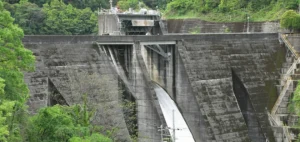Baihetan, a hydroelectric power plant project in China on the Jinsha River, is expected to begin producing electricity.
An ideal site
Baihetan is a 16GW Chinese hydroelectric power plant. The plant has 16 of the largest hydroelectric production units in the world. In addition, each unit has an installed capacity of 1GW.
The Baihetan hydroelectric power plant is capable of producing 62,400GW of electricity per year. Thus, the site is capable of supplying the electricity needs of approximately 75 million people. In addition, the site appears to be the largest hydroelectric dam under construction in terms of volume.
The Baihetan Dam adopts a double-curved arch dam configuration. Thus, it curves in the direction of the width and the length. In addition, it is located in the valley of the river, where the hydrostatic pressure can spread over the rocky mountains.
This design also effectively saves construction materials while improving safety. The 289-meter high dam consumed about eight million cubic meters of low temperature cement. The Baihetan dam has three unpressurized spillways.
A corridor of energy
In addition to Baihetan, the Jinsha River is home to three other projects. Indeed, the river hosts the 13.86GW Xiluodu station, the 10.2GW Wudongde station and the 6.4GW Xiangjiaba station. Thus, all the sites bring the total capacity to more than twice the capacity of the Three Gorges Dam.
The amount of clean energy generated by Baihetan saves up to 19.68 million tons of coal. Thus, the project reduces carbon dioxide emissions by 51.6 million tons. In addition, Baihetan generated more than 53 billion kWh of electricity since the first two units were commissioned in June 2021.
Baihetan is also part of China’s “East Powered by the West” project. The project is an effort to transmit electricity from the west to the energy-intensive regions of eastern China. Two power transmission lines will send electricity to Jiangsu and Zhejiang provinces.
The Baihetan-Jiangsu line is 2080 kilometers long. The Baihetan-Zhejiang line has a total distance of 2140.2 kilometers. The Baihetan-Zhejiang line is expected to become operational in 2023 and carry 8,000MW of electricity.






















